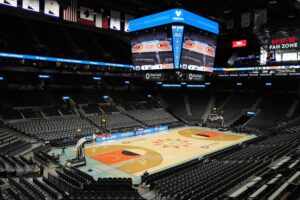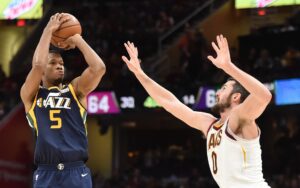LWOS coverage of the NCAA continues with the West Coast Conference basketball preview. The Gonzaga Bulldogs have primarily dominated this conference. Some teams may have a chance to challenge them this year, but it doesn’t look likely. Recently, the West Coast Conference has also had great success from other groups like St. Mary’s and BYU. Unfortunately for the WCC, BYU is moving to the Big 12 conference soon. Anyways, this preview will include every team in the West Coast Conference with the key players on each team. There will also be a section on the conference awards for the season, including player of the year, coach of the year, and rookie of the year.
West Coast Basketball: a Preview of the Teams and an Outlook for the 2021-22 Season
10. Portland Pilots
Key returners: Clythus Griffith
Key losses: Ahmed Ali, Eddie Davis, Latrell Jones
Key Newcomers: Tyler Robertson (Eastern Washington), Chris Austin (Fordham), Mike Meadows (EWU), Matija Svetozarevic
The Pilots went 0-11 in West Coast Conference play last season. This year they are incredibly young, including six first-year students and only three returning players on the roster. Unfortunately for the Pilots, they lost their three top scorers from last season, Ahmed Ali, Eddie Davis, and Latrell Jones. These players averaged a total of 41 points per game. However, transfer Tyler Robertson, Chris Austin, and Mike Meadows can make an impact. All three of these transfers averaged double figures at their previous schools. In addition, freshmen Matija Svetozarevic brings club experience in Serbia and a high basketball IQ. The Pilots play a pedestrian schedule this season, but Arizona State and Oregon are part of their slate. These two games are good, but they are not enough to prepare them for West Coast Conference play. Therefore, they will remain at the bottom of the league.
9. Pacific Tigers
Key returners: Jeremiah Bailey, Jordan Bell, Pierre Crockrell II
Key losses: Daniss Jenkins, Broc Finstuen
Key newcomers: Greg Outlaw (CCSU), Nick Blake (UNLV), Sam Freeman (Minnesota)
Pacific lost two critical players Jenkins and Finstuen from last season. Together they averaged 23 points per game. However, they return double-figure scorers Jeremiah Bailey and Pierre Crockrell II. In addition, the Tigers bring in three impact transfers in Outlaw, Blake, and Freeman. Blake averaged 27.2 points per game in high school but took a redshirt at UNLV. Despite this influx of talent, their non-conference schedule is very disappointing; the best team they will play in is California. As a result, the Tigers will have no big-game experience heading into West Coast Conference play. For this team to succeed, they will need to come together and play up to Gonzaga’s or Saint Mary’s level. This prospect is unlikely since they only have three seniors on the roster.
8. San Diego Toreros
Key returners: Joey Calcaterra, Josh Parrish, Vladimir Pinchuk
Key losses: Finn Sullivan, Yauhen Massalski, Jared Rodriguez
Key newcomers: Bryce Monroe, Jase Townsend, Marcellus Earlington
The Toreros return many impact players from last year, including Calcaterra, Parrish, and Pinchuk. Together these three players averaged thirty points per game. However, they lost some critical pieces, including Massalski. Massalski was their leading rebounder who transferred to San Francisco after the season, hurting their team’s rebounding ability. San Diego added Bryce Monroe, Jase Townsend, and Marcellus Earlington; these three acquisitions will help increase their depth at the guard position. However, none of these players average more than five rebounds per game. Without a gang rebounding concept, this team will struggle when they face teams with height like Gonzaga. The Toreros also only face three good teams in non-conference play, which is not enough to prepare them for West Coast Conference play.
7. Santa Clara Broncos
Key returners: Josip Vrankic, Jalen Williams, Keshawn Justice
Key losses: Guglielmo Caruso, Christian Carlyle
Key newcomers: Brenton Knapper, Carlos Stewart, PJ Pipes (Green Bay)
The Broncos lack some height that will affect them against Gonzaga and BYU in conference play; they only have two players over 6 foot 9. One of their significant losses is 6 foot 11 Guglielmo Caruso; he could have helped them make up for that deficiency. However, Santa Clara has elite guard play that includes Jalen Williams and newcomer PJ Pipes. Pipes averaged 14 points a game at Green Bay last season. The Broncos schedule is significantly better than the Terreros or Tigers; this includes Stanford, Nevada, TCU, Fresno State, California, and Boise State. These six games will be immense challenges for them to prove that they are ready for conference play. However, I do not think they can live up to their potential with their lack of height this season.
6. Pepperdine Waves
Key returners: Jade’ Smith, Jan Zidek
Key losses: Colbey Ross, Kessler Edwards
Key newcomers: Keith Fisher III, Braun Hartfield (San Diego)
The Waves lost a monumental amount of talent from last season, including Colbey Ross and Kessler Edwards. These two players were dynamic guards that were big-game players. In addition, Pepperdine does not bring back any double-figure scorers from last season. This lack of experience and scoring ability will hurt them immensely against more formidable opponents. However, they have a significant amount of frontcourt depth with Hartfield and Zidek. These two players will help them stay out of the bottom of the West Coast Conference this season. The Waves play a decent schedule with three good opponents Oregon, TCU, and Nevada. They will not be prepared for West Coast Conference play because of their inexperience at the guard position. As a result, they will fall back to the middle of the conference this season.
5. San Francisco Dons
Key returners: Jamaree Bouyea, Khalil Shabazz, Dzmitry Ryuny
Key losses: Taavi Jurkatamm
Key newcomers: Yauhen Massalski (San Diego), Ndewedo Newbury
The Dons return with immense talent, including Jamarre Bouyea, Khalil Shabazz, and Dzmitry Ryuny. Together, these three players averaged 41 points per game last season. San Fransisco also has significant experience on its roster with four seniors. The Dons bring in transfer Yauhen Massalski from San Diego. Massalski averaged 8.4 rebounds per game the previous year; his superior post play will help make the Dons frontline stronger. Ndewedo Newbury is a major another major frontcourt acquisition that makes them a formidable challenge down low. Despite great additions and returners, their schedule is underwhelming; however, they play Nevada, UNLV, and Arizona State. In addition, they did not schedule a tournament where they played more challenging opponents. This foresight will make it challenging for San Francisco to compete with the top teams in West Coast Conference basketball. Nevertheless, the Dons are an improving team that can make waves in the WCC.
4. Loyola Marymount University Lions
Key returners: Eli Scott, Keli Leaupepe, Dameane Douglas
Key losses: Mattias Markusson
Key newcomers: David Elliott IV, Lamaj Lewis, James Nobles
The Lions have an immense amount of guard depth and athleticism on the roster, giving other teams problems. This guard depth includes Eli Scott and big-game player Keli Leupepe. Together, these two players averaged 28 points per game last season. However, they lost Mattias Markusson, a 7 foot 3 center who averaged ten points and six rebounds per game. Their newcomers give them incredible depth at the guard position, but they neglected to address the loss of Markusson’s height. Without height to compete with the top teams, the Lions will need to hit many threes each game. They are capable of doing this if they get hot but not consistently. Their schedule is more demanding than San Fransisco’s because it includes the Jacksonville Classic, facing Florida State and Missouri or SMU. This SOS edge will allow them to be more prepared for West Coast Conference basketball.
3. Brigham Young University Cougars
Key returners: Alex Barcello, Caleb Lohner, Trevin Knell
Key losses: Brandon Averette, Matt Haarms
Key newcomers: Te’Jon Lucas (Milwaukee), Seneca Knight (LSU), Paora Winitana
The Cougars are a team to watch this season in the West Coast Conference, but the losses of Averette and Harrms are immensely challenging for this team to overcome. Haarms was a 7 foot 3 beast down low that gave Gonzaga some issues last season. Without him, they lack post depth, which will hurt them. However, they bring back star guard Alex Barcello, a big-game player who led them to a tournament appearance last season. They also acquired some excellent guards in Lucas, Knight, and Winitana. These three players should play significant roles this season. The Cougars play an intense schedule, including San Diego State, Oregon, Utah, Utah State, Creighton, and potentially Stanford. These games will help prepare them for West Coast Conference basketball. Gang rebounding is the key for the Cougars to compete this year.
2. Saint Mary’s Gaels
Key returners: Tommy Kuhse, Logan Johnson, Matthias Tass, Dan Fotu
Key losses: none!
Key newcomers: Chris Howell, Augustas Marciulionis
The Gaels have an excellent roster with experienced guard play and good post-depth. If someone is going to challenge Gonzaga, it will be Saint Mary’s. The return of Tommy Kuhse, Logan Johnson, Matthias Tass, and Dan Fotu allow this team to keep the same core and have continuity immediately. Tass is the Gaels best post player, but if Saint Mary’s will contend, they need more from Matt Van Komen. Van Komen is 7 foot 4; they will need his height against Gonzaga’s immense size. The Gaels have some demanding tests on their schedule, including Notre Dame, Oregon, San Diego State, and Utah State. These opponents will prepare them for West Coast Conference basketball. However, the Gaels have all the tools to make a run in the tournament this year.
1. Gonzaga Bulldogs
Key returners: Drew Timme, Andrew Nembhard, Anton Watson
Key losses: Corey Kispert, Jalen Suggs, Joel Ayayi
Key newcomers: Chet Holmgren, Rasir Bolton (Iowa State), Hunter Sallis
The Bulldogs are the most complete team in the West Conference and maybe the country. Despite losing three key players Kispert, Suggs, and Ayayi, Gonzaga has extreme post depth that will be challenging to guard, including Chet Holmgren and Drew Timme. The twin towers will create matchup nightmares for opponents all season long. Most experts believe that they will dominate West Coast Conference play this season. Essentially that sounds right, but The Gaels can give them some trouble. Saint Mary’s has three players 6 foot 10 or taller on their roster and excellent guard play. Gonzaga lost significant guard play, although the pickup of Rasir Bolton will help their cause significantly. Their schedule is intense, including Texas, UCLA, Duke, Alabama, Washington, and Texas Tech. These games will make them tournament-ready and establish them as a threat to win in all in March.
West Coast Conference Basketball Preview: League awards
Player of the Year: Drew Timme – Gonzaga
Timme is the best player in the West Coast Conference; he averaged 19 points last season and seven rebounds. This season he will play even better. Teams will have to double Holmgren to stop him from scoring down low, opening up Timme for even more opportunities. This increased usage will make his path to player of the year easy.
Coach of the Year: Randy Bennett – Saint Mary’s University
Randy Bennett is an excellent coach, but his Gaels were in seventh place in the conference last year. If they improve to second, as I predict, there is no reason he should not win the coach of the year. His team can get some huge wins this season and make a deep tournament run.
Rookie of the Year: Chet Holmgren – Gonzaga
Holmgren is the most towering presence in the West Coast Conference. His sheer size will make teams have to leave their shooters open. In addition, Holmgren has elite rebounding ability and great post moves that make his size even more challenging. If Holmgren develops an outside game, he will become an incredible NBA prospect this season.
Main Photo:
Embed from Getty Images






